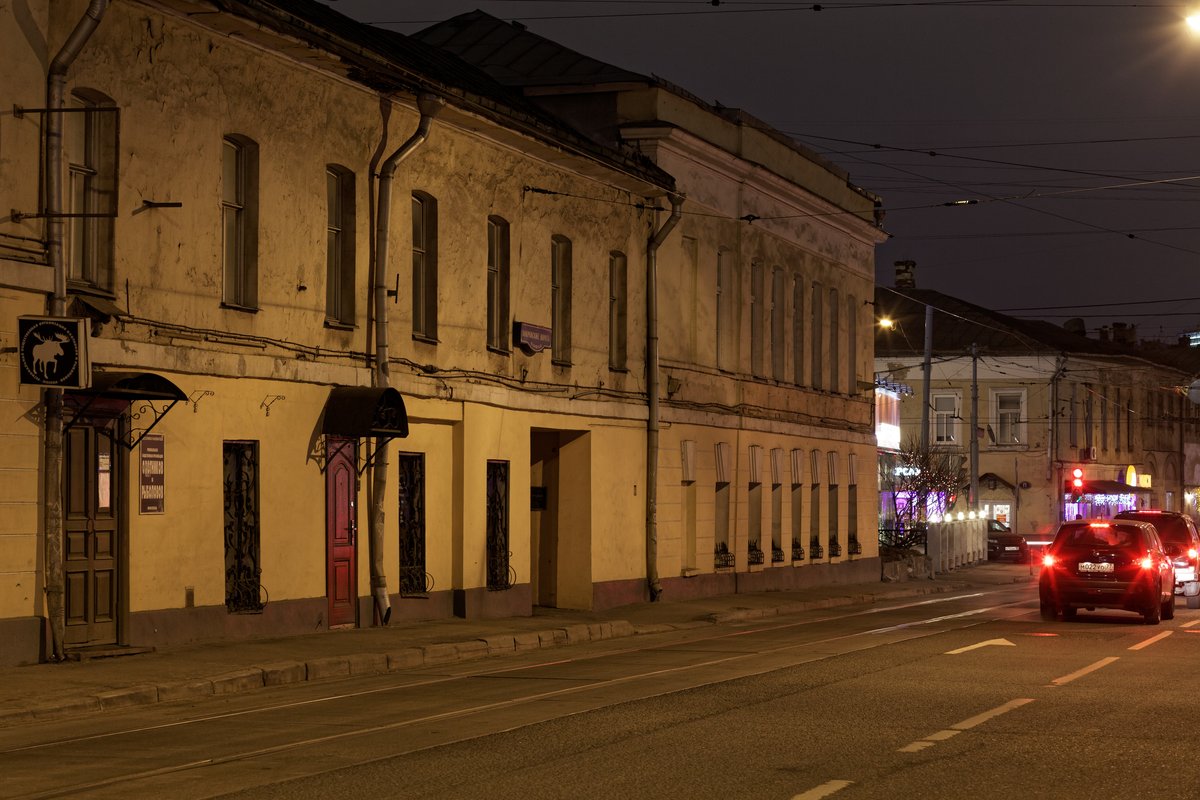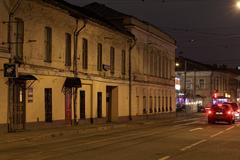
Pokrovsky Boulevard Visiting Hours, Tickets, and Tourist Guide: Moscow Historical Sites
Date: 14/06/2025
Introduction
Pokrovsky Boulevard, nestled within Moscow’s historic Boulevard Ring, stands as a testament to the city’s evolving urban identity. Once the site of medieval fortifications, today it offers a harmonious blend of architectural heritage, tranquil green spaces, and vibrant cultural life. As the youngest segment of the Boulevard Ring, Pokrovsky Boulevard embodies both Moscow’s aristocratic past and its dynamic present, attracting history enthusiasts, architecture aficionados, and casual strollers alike.
This detailed guide brings together essential visitor information—covering visiting hours, ticketing, accessibility, guided tours, and nearby attractions—drawing on authoritative sources such as the Higher School of Economics (hse.ru), Moscow tourism portals (moscovery.com), and urban planning analyses (ArchDaily). Prepare to explore a microcosm of Moscow where history, culture, and daily life intertwine.
Historical Overview: From White City to Boulevard Ring
Pokrovsky Boulevard’s origins are deeply rooted in the transformation of the White City (Bely Gorod), which formed Moscow’s third defensive ring in the late 16th century. Its formidable limestone walls protected the city’s elite, but by the late 18th century, these fortifications had become obsolete. In 1774, the city dismantled the walls and planted tree-lined boulevards in their place, following a European trend of converting former defense structures into public promenades (friendlylocalguides.com). The Boulevard Ring—ten connected boulevards forming a green horseshoe—emerged as a defining urban feature, with Pokrovsky Boulevard officially appearing in 1891.
19th-Century Development and Architectural Character
Following Catherine the Great’s reforms, land along the former White City walls became available for development. While much was acquired by Moscow’s merchants, construction on Pokrovsky Boulevard accelerated in the late 19th century. Notably, in 1878, merchant Vassily Medyntsev commissioned architect Dmitri I. Pevnitsky to design number 6 Pokrovsky Boulevard; in 1881, number 8 was added, blending classical elements with eclectic details (hse.ru). Later, architect Flegont F. Voskresensky expanded number 8, integrating Art Nouveau influences and subtle asymmetries that characterize the building’s façade.
The boulevard’s architecture today showcases a tapestry of styles: neoclassical mansions, Art Nouveau details, and modern renovations. Notable interiors include original plasterwork and Roman mosaic floors, reflecting the era’s taste for both grandeur and ornamentation (hse.ru).
Social and Cultural Significance
Pokrovsky Boulevard has always been more than a residential address. Its buildings have housed girls’ gymnasiums, editorial offices of the Great Soviet Encyclopedia, and the homes of renowned artists. The broader Boulevard Ring was immortalized by writers like Tolstoy and Bulgakov and served as a social promenade for Muscovites of all backgrounds (friendlylocalguides.com). Seasonal festivals, open-air exhibitions, and performances continue to enliven the boulevard, affirming its role as a conduit for Moscow’s vibrant public life.
20th-Century Transformations and Urban Renewal
The 20th century saw Pokrovsky Boulevard witness revolutionary barricades and later play a defensive role during World War II. Post-war revitalization brought thousands of new trees and shrubs, while the “Annushka” tram route, introduced in 1880, integrated the boulevard into the city’s daily rhythms (friendlylocalguides.com). In 1978, the Boulevard Ring was declared a monument of landscape art, ensuring its preservation.
Recent urban renewal initiatives, such as Moscow’s “My Street” program, have further enhanced Pokrovsky Boulevard’s pedestrian and cycling infrastructure, upgraded public transport links, and restored historic façades (ArchDaily). Today, the boulevard exemplifies Moscow’s ability to blend historical preservation with contemporary urban planning.
Visiting Pokrovsky Boulevard: Hours, Tickets & Accessibility
Visiting Hours:
Pokrovsky Boulevard is a public thoroughfare open 24 hours a day, year-round. There are no entrance fees or tickets required to explore the boulevard itself.
Accessibility:
The boulevard features wide, paved walkways, ramps at major crossings, and dedicated bike lanes. Most underground pedestrian passages are equipped with ramps, making the area accessible for wheelchair users and those with mobility challenges. Some historic buildings, however, may have limited accessibility—check with specific sites for details.
Guided Tours and Special Events:
While the boulevard itself is freely accessible, guided city tours often include Pokrovsky Boulevard, focusing on its architecture and history. The Higher School of Economics occasionally offers guided visits to its historic buildings. Check the Moscow Tourism website and local event listings for current tours and seasonal events.
Key Sights and Cultural Landmarks
Durasov House
A standout example of late 18th-century Russian Classicism, the Durasov House once belonged to nobleman Nikolay Durasov and has served various notable owners. Now part of the Higher School of Economics campus, it features an elegant façade and intricate interiors (HSE Pokrovka History).
Public Access: The exterior is viewable at any time; interior access may be possible during special events.
Boulevard Ring and Bely Gorod Wall Fragment
At the northern end of Pokrovsky Boulevard, visitors can see a preserved fragment of the Bely Gorod wall and a modern amphitheater that hosts performances and community events (RBTH Must-Visit Places).
Historic Mansions and Estates
The boulevard features a range of historic mansions—many now repurposed as educational or cultural institutions—offering an architectural journey from neoclassical to eclectic styles. Notable sites nearby include the Fedor Osterman mansion and the Flat-Iron House in the Khitrovka district (HSE Pokrovka).
Parks and Green Spaces
Chistiye Prudy (Clean Ponds)
A beloved recreational area at the western end of Pokrovsky Boulevard, Chistiye Prudy offers boating in summer and ice skating in winter (HSE Pokrovka).
Milyutinsky and Morozovsky Gardens
These tranquil green spaces are rich in literary and artistic history, having been frequented by figures like Chekhov and Serov. Milyutinsky Garden is particularly known for its connection to philanthropist Savva Morozov and artist Isaak Levitan (HSE Pokrovka).
Cultural and Artistic Attractions
Museum of Unique Dolls
A short walk from the boulevard, this museum showcases handcrafted dolls and Russian folk art (HSE Pokrovka).
Hours: Tuesday–Sunday, 10 AM–6 PM; check the museum’s site for details.
Khitrovka District
Once infamous for its underworld, Khitrovka is now a romanticized neighborhood featuring historic mansions, cathedrals, and memorials. Explore with the free IZI Travel audio guide (in Russian) (HSE Pokrovka).
Dining, Nightlife, and Creative Spaces
Pokrovsky Boulevard and its surroundings offer diverse culinary and nightlife options, from cafes and bakeries to live music venues and art galleries (Wanderboat). The area is noted for its community-oriented creative hubs and frequent public art installations.
Transportation and Getting Around
Metro Access:
Chistye Prudy, Kurskaya, and Kitay-Gorod stations are within walking distance (Boulevard Ring Map). Tram No. 39 terminates at Chistiye Prudy. Consider a Troika card for efficient travel (Owl Over The World).
Cycling:
Dedicated bike lanes connect Pokrovsky Boulevard with other green corridors and parks.
Seasonal Events and Activities
Pokrovsky Boulevard hosts seasonal festivals, open-air art exhibitions, and citywide celebrations, especially during Moscow City Day (Events Calendar Moscow). In spring and summer, the green spaces are vibrant with activity; winter brings festive decorations and skating at Chistiye Prudy.
Visitor Practicalities: Tips and Etiquette
- Language: English spoken in tourist venues; basic Russian helpful. Yandex Translate is useful (Owl Over The World).
- Currency: Russian ruble; cards widely accepted—carry some cash.
- Safety: Moscow is generally safe; carry ID, be cautious at night.
- Connectivity: Local SIM recommended; Yandex Maps and Metro app are useful.
Frequently Asked Questions (FAQ)
Q: What are Pokrovsky Boulevard’s visiting hours?
A: Open 24/7 as a public space.
Q: Is there an entrance fee?
A: No; access is free. Some nearby museums or events may charge admission.
Q: Is Pokrovsky Boulevard wheelchair accessible?
A: Yes, with ramps at major crossings and smooth pavements; some historic interiors may have limited access.
Q: How do I get there?
A: Walk from Chistye Prudy, Kurskaya, or Kitay-Gorod metro stations; tram and bus routes are also available.
Q: When is the best time to visit?
A: Late spring to early autumn (May–September) offers the most pleasant weather and outdoor activity options.
Summary and Recommendations
Pokrovsky Boulevard is a quintessential Moscow destination, embodying centuries of architectural evolution, urban greenery, and cultural vibrancy. Its free, pedestrian-friendly spaces invite exploration year-round, while nearby parks, historic mansions, and seasonal events enrich the experience. Excellent public transport and modern amenities ensure accessibility for all visitors. For a comprehensive Moscow itinerary, combine Pokrovsky Boulevard with adjacent historical districts and renowned landmarks.
For up-to-date information, consult official resources such as moscovery.com, hse.ru, and ArchDaily. Download the Audiala app for offline maps and curated audio tours, and follow related posts for insider tips.
Sources and Further Reading
- Visiting Pokrovsky Boulevard: History, Hours, Tickets & Travel Tips, 2024, Friendly Local Guides
- Pokrovsky Boulevard Historical and Architectural Overview, 2024, Higher School of Economics
- 8 Projects That Exemplify Moscow’s Urban Movement, 2024, ArchDaily
- Pokrovsky Boulevard Visitor Information, 2024, Moscow Tourism Portal Moscovery
- Moscow Travel Tips, 2024, Owl Over The World
For more, explore our related articles:





















































































































































































































































































